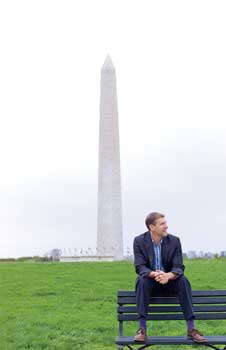Is there any viable solution for energy today, what with tsunamis hitting nuclear plants, offshore rigs spewing oil, natural-gas wells leaking fracking fluids, and wind turbines killing birds? To unravel the confusion, we turned to physicist Dan Kammen. As the founding director of the Renewable and Appropriate Energy Laboratory at the University of California at Berkeley and lead author of numerous Intergovernmental Panel on Climate Change reports, 49-year-old Kammen has long been one of the clearest thinkers on renewable energy. Now, as the man in charge of clean energy at the World Bank, he’s taking on the globe.
HIGHTOWER ALLEN: As The New York Times put it, you’re the World Bank’s “clean-energy czar.” What does that mean?
KAMMEN: Well, I hope I don’t end up the way some czars of old have. Their track record in Washington, D.C., hasn’t been great. Czars have either a lot of power or no power, depending on who you ask. The World Bank’s lending for renewables is, depending on what metric you use, 50 to 65 percent of its entire portfolio of energy lending. So it’s a big deal by itself.
When it comes to our energy future, what’s the greatest myth you have to contend with?
That renewable energy is a distant vision—a goal we’d like to get to but aren’t close to. Actually, we’re quite close to bringing renewable in large amounts online, but we need to tweak the energy rules to reward this kind of generation.
How do you define renewables? We think of wind, solar, biomass… Is nuclear energy renewable?
Nuclear is generally in its own category; it’s low-carbon but not necessarily renewable. Solar, wind, biofuels, and ocean energy are generally thought of as the so-called new renewables. But none of them are zero-carbon.
So which of them should we focus on?
Wind and solar each have the potential to get to 20 percent of our electricity in the U.S. There has been a dramatic scale-up in wind power in the past few years in Germany, Denmark, Korea, Portugal, Spain, and parts of the U.S. In some countries, like Denmark, it is already 20 percent of electricity mixes, which is the plan for the U.S. So these scale-ups are happening, but they don’t require just technology innovation. The special sauce is in the process: market rules that reward clean energy.
Are you of the school that we’ll also need all the coal we can mine and all the oil we can drill?
No, I don’t think we have an energy crisis in terms of supply. We may have a sustainability crisis, but there is plenty of energy. We receive enough solar energy in six hours to run the planet for a year. When we combine that with wind and, for example, natural gas, where we are trying to capture the carbon that comes out, there are portfolios that make sense almost everywhere that are cleaner.
Colorado energy expert Randy Udall wrote that a typical American uses as much energy as a 66,000-pound primate and as much energy each day as there is in a lightning bolt.
It’s true. If we were as efficient in the country overall as we are in the states that have pushed this the most—New York, California, Wisconsin, Rhode Island—we would remove the need for more energy than we import from the Middle East.
Does nobody talk about this because it feels too much like Jimmy Carter suggesting we all wear sweaters?
No, I think it’s actually because it requires something that we’re not very good at, and that is a systems approach, meaning that you can’t get all these efficiency gains by just saying, “Go replace lightbulbs.” You have to think about the whole system.
If the U.S. did have a federal innovative-energy policy, what country would you model it on?
I would model it on homegrown innovations. We have seen very innovative policies in Texas, California, New York, Oregon, Washington, Hawaii, Connecticut. Many people in the federal government are already engaged in this effort, and it’s not easy. Up-front financing is a challenge.
Some members of Congress want to strip renewable-energy funding entirely. How do we sell this large-scale transition without using the words climate or green, which seem to have become dirty words in Washington?
First off, I’m not sure they are dirty in all areas. I do think that leading with climate has set back the process. But leading with clean, sustainable, pure energy and getting climate gains as a co-benefit is a strategy that some states have pursued. The 31 states—the majority—that have adopted clean-energy standards have found that you can actually get an economic gain from renewable energy, because you can diversify. Colorado found that installing wind stabilized electricity costs because it made the state less exposed to price fluctuations for natural gas.
With those economic benefits, why hasn’t renewable energy become a conservative cause?
Energy is the biggest industry on the planet, and making changes in that industry is risky. And we don’t value all the benefits of renewable. We don’t value the climate benefit. We don’t value the air-quality and health benefits of having less urban pollution from cleaner vehicles. If we don’t reflect those benefits in our economics, it’s hard to make them happen.�� ��
��


